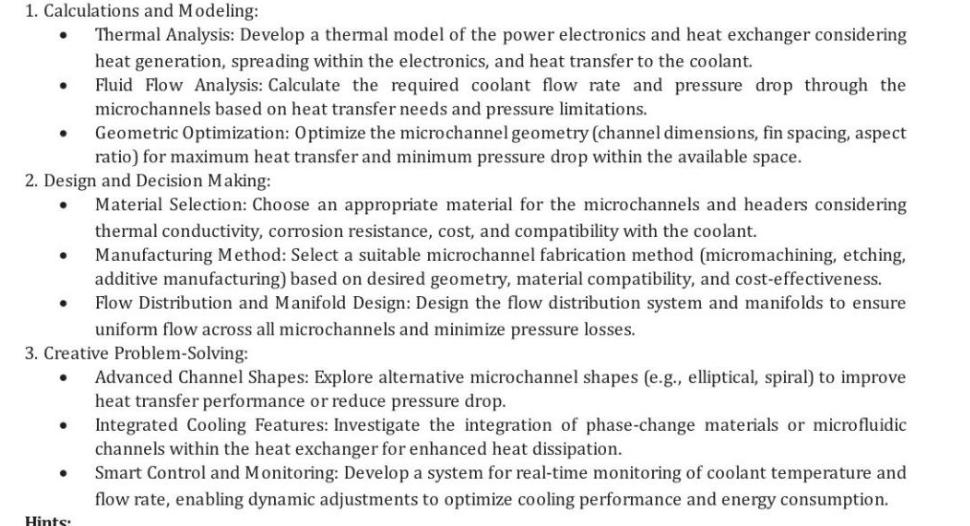Answered step by step
Verified Expert Solution
Question
1 Approved Answer
Design and optimize a microchannel heat exchanger for an electric vehicle (EV) charging station to efficiently transfer heat from the high-power electronics to a


Design and optimize a microchannel heat exchanger for an electric vehicle (EV) charging station to efficiently transfer heat from the high-power electronics to a cooling system while minimizing size, weight, and pressure drop. Data: Tasks: Power electronics heat generation: 50 kW (peak) Desired coolant temperature range: 20-40C Available space for the heat exchanger: limited within the charging station cabinet Coolant type (water, glycol mixture) and its properties (specific heat, viscosity) Pressure drop constraints for the coolant loop Material limitations for microchannel fabrication (e.g., copper, aluminum) 1. Calculations and Modeling: Thermal Analysis: Develop a thermal model of the power electronics and heat exchanger considering heat generation, spreading within the electronics, and heat transfer to the coolant. Fluid Flow Analysis: Calculate the required coolant flow rate and pressure drop through the microchannels based on heat transfer needs and pressure limitations. Geometric Optimization: Optimize the microchannel geometry (channel dimensions, fin spacing, aspect ratio) for maximum heat transfer and minimum pressure drop within the available space. 2. Design and Decision Making: Material Selection: Choose an appropriate material for the microchannels and headers considering thermal conductivity, corrosion resistance, cost, and compatibility with the coolant. Manufacturing Method: Select a suitable microchannel fabrication method (micromachining, etching, additive manufacturing) based on desired geometry, material compatibility, and cost-effectiveness. Flow Distribution and Manifold Design: Design the flow distribution system and manifolds to ensure uniform flow across all microchannels and minimize pressure losses. 3. Creative Problem-solving: Hints: Advanced Channel Shapes: Explore alternative microchannel shapes (e.g., elliptical, spiral) to improve heat transfer performance or reduce pressure drop. Integrated Cooling Features: Investigate the integration of phase-change materials or micro fluidic channels within the heat exchanger for enhanced heat dissipation. Smart Control and Monitoring: Develop a system for real-time monitoring of coolant temperature and flow rate, enabling dynamic adjustments to optimize cooling performance and energy consumption.
Step by Step Solution
There are 3 Steps involved in it
Step: 1

Get Instant Access to Expert-Tailored Solutions
See step-by-step solutions with expert insights and AI powered tools for academic success
Step: 2

Step: 3

Ace Your Homework with AI
Get the answers you need in no time with our AI-driven, step-by-step assistance
Get Started


